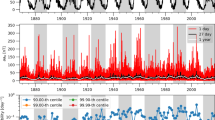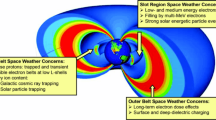Abstract
This paper considers the MHD structure and configuration of near-Earth interplanetary disturbances during the heliospheric extrastorm of November 2004, taking into account the effect of the IMF sector structure and using the measurements of near-Earth satellites. During three successive disturbance intervals, the Earth entered, remained and left a relative narrow positive sector with flare-active region 10696, which generated a series of shocks and an active transequatorial filament. It has been indicated that the MHD structure and configuration of near-Earth disturbances substantially and specifically (for each position) depend on the IMF sector structure and interactions between shocks and sector boundaries, filaments, and magnetic clouds in these three different positions. Specifically, this manifested itself in multiple crossings of sector boundaries and considerable deformations of magnetic clouds. It has been indicated that the models of circular clouds are applied with limitations under the considered conditions.
Similar content being viewed by others
References
Bisi, M.M., Jackson, B.V., Hick, P.P., Buffington, A., Odstrcil, D., and Clover, J.M., Three-Dimensional Reconstructions of the Early November 2004 Coordinated Data Analysis Workshop Geomagnetic Storms: Analysis of STELab IPS Speed and SMEI Density Data, J. Geophys. Res., 2008, vol. 113, p. AOOA11. doi:10.1029/2008JA013222
Chertok, I.M., Large-Scale Activity in Major Solar Eruptive Events of November 2004 according to SOHO Data, Astron. Zh., 2006, vol. 83, no. 1, pp. 76–87 [Astron. Rep. (Engl. Transl.), 2006, vol. 50, no. 1, p. 68].
Dasso, S., Nakwackl, M.S., Demoulin, P., and Mandrini, C.H., Progressive Transformation of a Flux Rope to an ICME, Sol. Phys., 2007, vol. 244, no. 1, pp. 115–137.
Harra, L.K., Grooker, N.U., Mandrini, C.H., et al., How Does Large Activity From the Same Region Produce Oppositely Directed Magnetic Clouds?, Sol. Phys., 2007, vol. 244, no. 1, pp. 95–114.
Ivanov, K.G., Superconcentration of Photospheric Sources of the Large-Scale Open Solar Magnetic Field in the Main Zone of Active Longitudes, Differential Rotation Blocking, and Origination of the Four-Sector Structure: 1. The Field and Solar Activity Dynamics, Geomagn. Aeron., 2009, vol. 49, no. 5, pp. 585–594 [Geomagn. Aeron. (Engl. Transl.), 2009, vol. 49, pp. 557–565].
Ivanov, K.G., Superconcentration of Photospheric Sources of the Large-Scale Open Solar Magnetic Field in the Main Zone of Active Longitudes, Differential Rotation Blocking, and Origination of the Four-Sector Structure: 2. Geoeffectiveness, Geomagn. Aeron., 2010, vol. 50, no. 1, pp. 3–16 [Geomagn. Aeron. (Engl. Transl.), 2010, vol. 50, pp. 1–14].
Ivanov, K.G., Displacement of Large-Scale Open Solar Magnetic Fields from the Zone of Active Longitudes and the Heliospheric Storm of November 3–10, 2004:1. The Field Dynamics and Solar Activity, Geomagn. Aeron., 2010a, vol. 50, no. 3, pp. 298–310 [Geomagn. Aeron. (Engl. Transl.), 2010a, vol. 50, pp. 285–297].
Ivanov, K.G., Displacement of Large-Scale Open Solar Magnetic Fields from the Zone of Active Longitudes and the Heliospheric Storm of November 3–10, 2004:2. “Explosion” of Singularity and Dynamics of Sunspot Formation and Energy Release, Geomagn. Aeron., 2010b, vol. 50, no. 6, pp. 1–16 [Geomagn. Aeron. (Engl. Transl.), 2010b, vol. 50, pp. 695–710].
Ivanov, K.G., Solar Sources of Interplanetary Shocks on November 7–11, 2004, Geomagn. Aeron., 2011, vol. 51, no. 1, p. 23. doi: 10.1134/S001679321101004X
Ivanov, K.G. and Kharshiladze, A.F., MHD Nature of the Origination, Dynamics, Geoeffectiveness, and Disappearance of the Four-Sector Structure of the Solar Magnetic Field during the Cycle 23 Decline Phase, Geomagn. Aeron., 2009, vol. 49, no. 3, pp. 291–307 [Geomagn. Aeron. (Engl. Transl.), 2009, vol. 49, pp. 273–289].
Ivanov, K.G. and Romashets, E.P., Some Typical and Unusual Events of Solar-Terrestrial Physics in January-June 1999, Geomagn. Aeron., 2000, vol. 40, no. 5, pp. 15–24 [Geomagn. Aeron. (Engl. Transl.), 2000, vol. 40, pp. 556–564].
Ivanov, K.G., Romashets, E.P., and Vandas, M., The Series of Solar-Terrestrial Extrastorms of May-October 2000. 4. Structure of the Bow Shock Layer and Configuration of the Near-Earth Magnetic Cloud on July 15, Geomagn. Aeron., 2005, vol. 45, no. 3, pp. 336–346 [Geomagn. Aeron. (Engl. Transl.), 2005, vol. 45, pp. 315–325].
Ivanov, K.G., Romashets, E.P., and Kharshiladze, A.F., Solar-Terrestrial Storm of November 18–20, 2003. 1. Near-Earth Disturbances in the Solar Wind, Geomagn. Aeron., 2006, vol. 46, no. 3, pp. 291–309 [Geomagn. Aeron. (Engl. Transl.), 2006, vol. 46, pp. 275–293].
Longcope, D., Beveridge, C., Oiu, J., Ravindra, B., Barnes, and Dasso, S., Modeling and Measuring the Flux Reconnected and Ejected by the Two Ribbon Flare/CME Event on 7 November 2004, Sol. Phys., 2007, vol. 244, no. 1, pp. 45–73.
Pohjolainen, S., Diel-Gesztelyi, J.L., Manoharan, P.H., and Elliott, H.A., CME Propagation Characteristics from Radio Observations, Sol. Phys., 2007, vol. 244, no. 1, pp. 167–188.
Vandas, M. and Romashets, E.P., Force Free Field with Constant Alpha in an Oblate Cylinder: A Generalization of the Lundquist Solution, Astron. Astrophys., 2003, no. 398, pp. 801–807.
Vandas, M., Fisher, S., Dryer, M., Shuth, Z., Detman, T., and Geranios, A., MHD Simulation of an Interaction of a Shock Wave with a Magnetic Cloud, J. Geophys. Res., 1997, vol. 102, no. 12, pp. 22 295–22 300.
Wang, J., Zhang, Y., Zhou, G., Harra, L.K., Williams, D.R., and Jiang, Y., Solar trans-Equatorial Activity, Sol. Phys., 2007, vol. 244, no. 1, pp. 75–94.
Williams, D.R., Torok, T., Demoulin, P., Driel-Gesztelyi, L., and Kleim, B., Eruption of Kink-Unstable Filament in NOAA Active Region 10696, Astrophys. J., 2005, vol. 627, pp. L163–L166.
Yermolaev, Yu.I. et al., A Year Later: Solar, Heliospheric, and Magnetospheric Disturbances in November 2004, Geomagn. Aeron., 2005, vol. 45, no. 6, pp. 723–763 [Geomagn. Aeron. (Engl. Transl.), 2005, vol. 45, pp. 681–719].
Author information
Authors and Affiliations
Additional information
Original Russian Text © K.G. Ivanov, 2011, published in Geomagnetizm i Aeronomiya, 2011, Vol. 51, No. 3, pp. 291–302.
Rights and permissions
About this article
Cite this article
Ivanov, K.G. MHD structure of interplanetary disturbances observed near the earth during the solar-terrestrial storm of November 7–13, 2004. Geomagn. Aeron. 51, 287–298 (2011). https://doi.org/10.1134/S0016793211030078
Received:
Published:
Issue Date:
DOI: https://doi.org/10.1134/S0016793211030078




